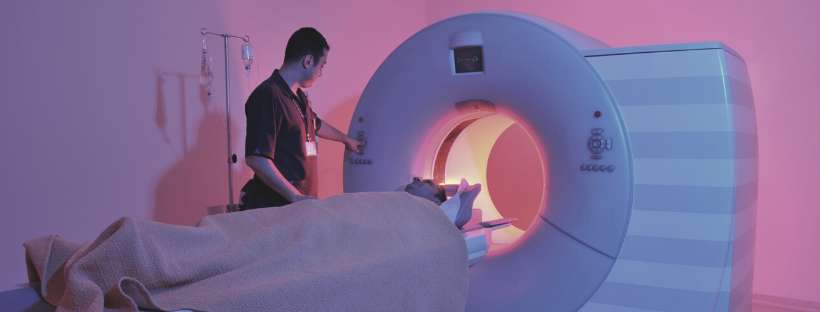
I get this question ALL the TIME – from my parents, from my husband, from my friends, and even from my clients. Do I need an MRI? Should I go see the doctor? urgent care? ER?!
My husband came home last week with a sprained ankle. He thinks he’s still 20 and Kobe, and joined a recreational basketball league to keep up with his cardio (and also to prove he’s still got it ;)). FIVE minutes and 6 points into his Tuesday night game, he landed on his opponents foot, and down he went. He hobbled in the door 45 minutes later, asking me to help him. “Should I go to urgent care?”, he asked me. “Do you think I need an MRI? Do you think I tore something? Is it broken?” All of these, by the way, were valid questions, considering he had a moderate amount of swelling, had trouble bearing weight, and the bruising was already setting in.
“Should I go to urgent care?”, he asked me. “Do you think I need an MRI? Do you think I tore something? Is it broken?”

After evaluating how he was moving, performing a few special tests, and taking into consideration his clinical presentation, objective measures, his subjective information (like pain levels, how it happened, medical history etc), and his goals (pain free, and play basketball again), I told him to wait on an urgent care visit and imaging. Why, when he had to hobble to and from work on crutches, would I tell him to wait, you ask?
|| Why, when he had to hobble to and from work on crutches, would I tell him to wait, you ask?
Imaging is an excellent tool that allows us to see what is happening beneath the surface. It helps us detect fractures, arthritis, and calcifications with X-rays, and damage to soft tissue structures (torn ligaments, tendons, edema etc) with MRI’s. But MRI’s dont evaluate FUNCTION. They don’t dictate how you move, they can’t tell you how much pain you should be in, and in some cases, the angle of the image alone can give us a skewed perception of what is actually happening within a given space. Even moreso, there are plenty of research articles out there that look at positive MRI results in patients that have strong, functional and otherwise healthy joints! They can be useful in confirming an injury that is presenting in a typical clinical fashion, and even in diagnosing an injury that is NOT presenting in a typical manner, but in MANY cases, an MRI leads to discussions about surgery that is not always warranted, or confirm the already established plan of care (aka go back to physical therapy)
|| MRI’s don’t evaluate FUNCTION. They don’t dictate how you move, they can’t tell you how much pain you should be in, and in some cases, the angle of the image alone can give us a skewed perception of what is actually happening within a given space.

So, before you rush to the nearest urgent care, orthopedic doctor, or emergency room, take a few minutes to consider the following over the course of the first 5-7 days:
-
Can you move it? Are you unable to move your ankle? your shoulder? Does it just hurt to move it, or is your range of motion more limited than previously?
-
Is there swelling? Does that swelling respond to ice, anti-inflammatories, or intermittent compression? Does it feel like the swelling is inhibiting your ability to move freely? (if you are looking for anti-inflammatory supplements without the side effects of traditional medications, check out an article about turmeric extract here)
-
How much pain are you in? Can you walk on that leg easily, not at all or somewhere in the middle? Is it excruciating to lift your arm to brush your hair, or is the pain more of an annoyance?
-
Can you activate the muscles around the pain? Do you feel stable? If it’s your shoulder, can you lift it against gravity? what about with resistance? Does your knee feel like it will buckle if you don’t have some type of external support?
-
How did you hurt yourself? Is this an injury that was the result of you falling off the roof? Did you slip and fall? or did step in a hole while walking the dog? The more traumatic the mechanism, the more likely that there is trauma to the tissue.
The first few days after an injury, you are likely to feel the most pain, most swelling, and most restriction in range of motion, strength, and stability. The goal is to look for improvements in these categories. Look for improvements in swelling with the use of NSAIDs (advil), ice, and gentle range of motion. Look for improvements in function, in pain levels and range of motion as swelling starts to subside.
Getting a little bit better but still painful and limited? See your favorite physical therapist! Most states allow direct access, which means that you do not need a referral or prescription in order to see a PT for a period of time. If they evaluate you and think you need a referral, they will guide you through that process, but in most cases, they will develop a plan of care to get you back on your feet (or back to your goals) without the extra cost of an MRI or doctors visit.
You feel worse, or no improvement at all? Head to your physician, and discuss your next step with them. In many cases, because of healthcare stipulations, they will STILL send you to PT first, before ordering an MRI, but if you are paying out of pocket, or have one of the select few insurance plans that allow it, your physician will write you a prescription for an MRI if they see fit.
In both my professional and personal opinion, the BEST thing you can do is start with physical therapy. IF you have an injury that will ultimately require surgery, you have an opportunity to minimize pain/swelling, optimize function and “prehab” or set yourself up for a successful rehab post-surgery…. and if not, BEST CASE SCENARIO, you have a physical therapist who helps you meet your functional goals without the need for additional expenses, claustrophobic machines, and doctors offices that can’t accommodate you on their schedule for the next 8 weeks.
Don’t have a favorite PT? I now offer TelePT session that comply with HIPPA requirements. Contact me here to schedule a TelePT evaluation!
**Disclaimer: These recommendations are guidelines only and do not take into consideration individual medical history, complicating factors, etc. The Content is not intended to be a substitute for professional medical advice, diagnosis, or treatment. Always seek the advice of your physician or other qualified health provider with any questions you may have regarding a medical condition.

